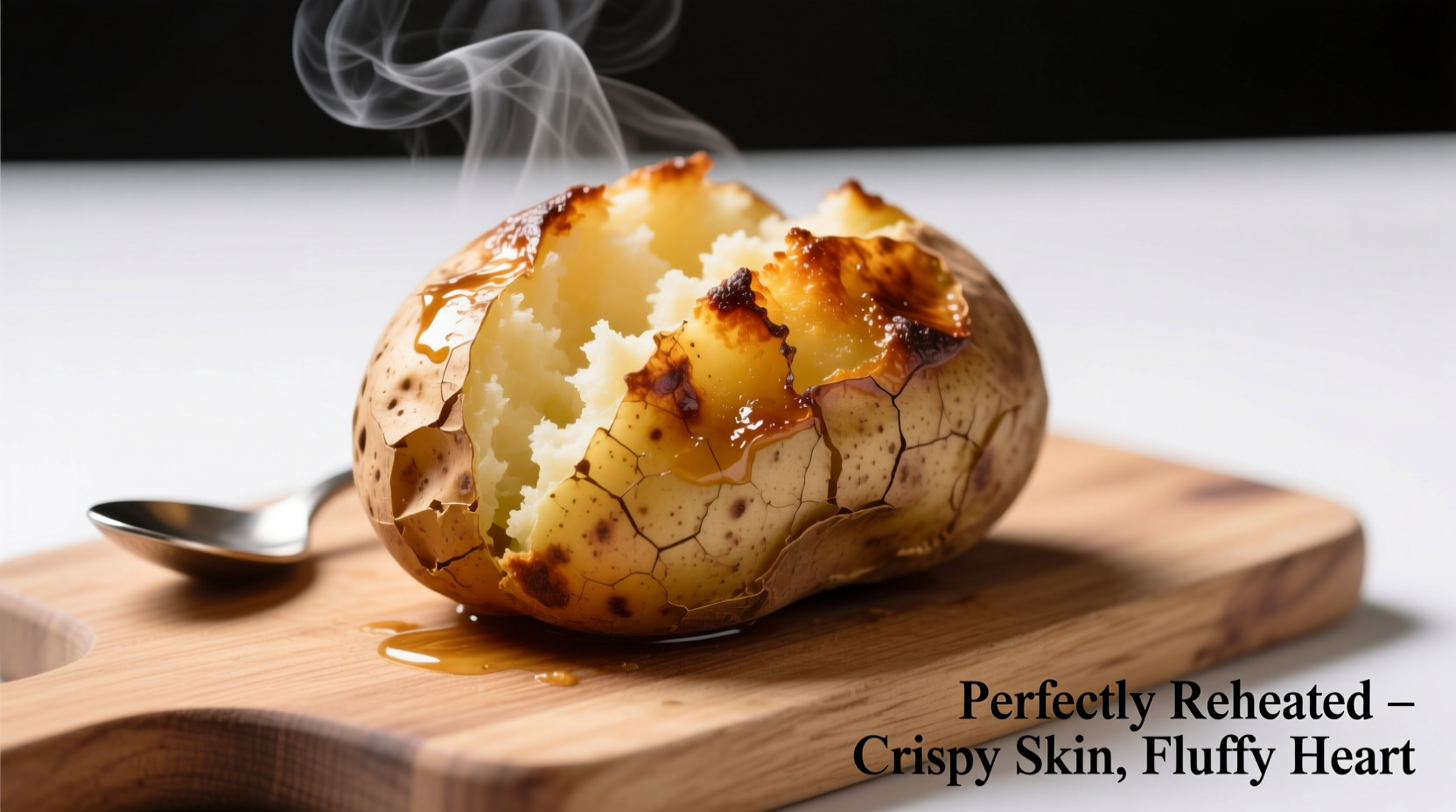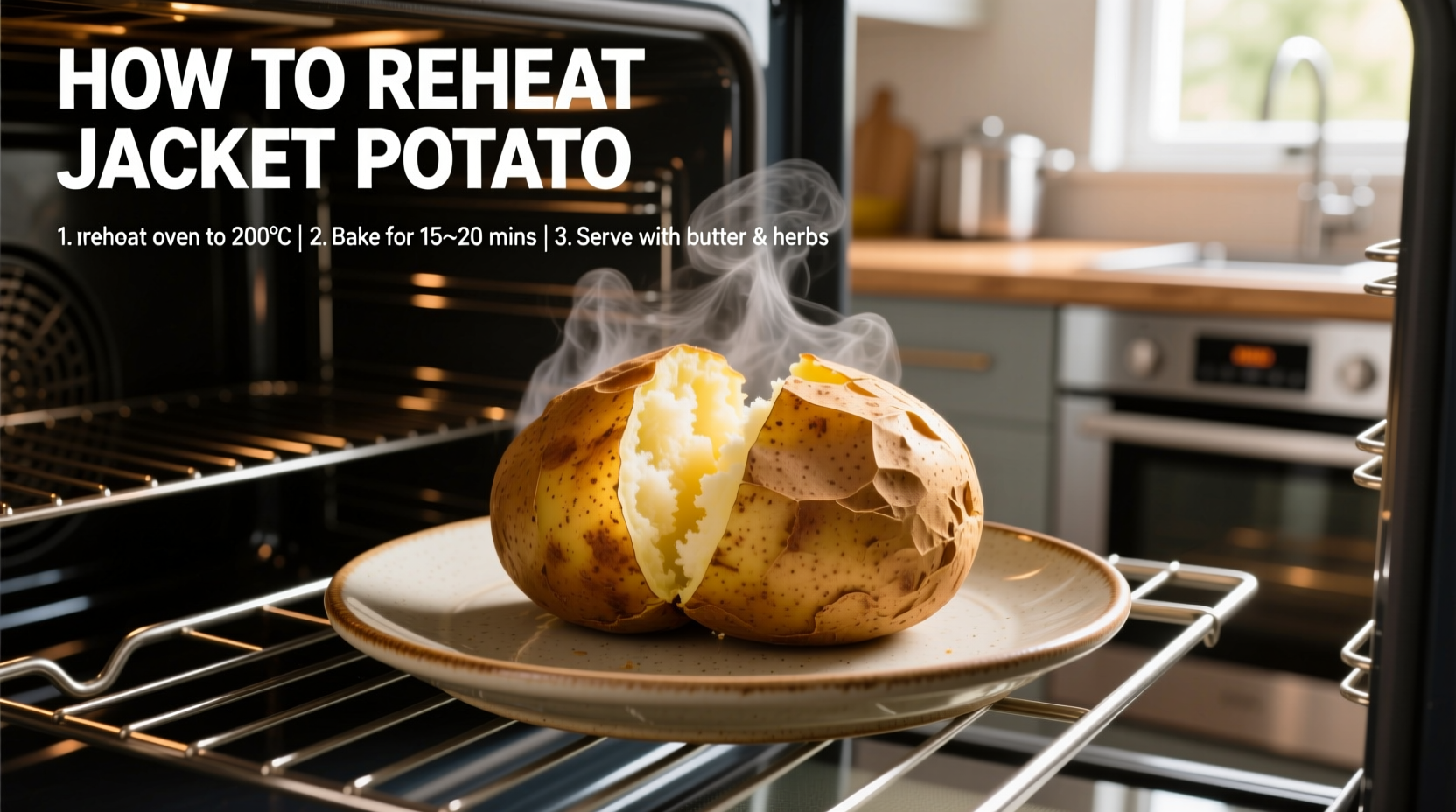Why Proper Reheating Matters for Jacket Potatoes
Reheating a jacket potato correctly preserves both texture and safety. Potatoes contain starch that hardens when cooled, then softens again when reheated properly. But improper reheating creates food safety risks - cooked potatoes left at room temperature can develop Clostridium botulinum, the bacteria causing botulism. The USDA Food Safety and Inspection Service emphasizes that cooked potatoes should never sit at room temperature for more than two hours.

Step-by-Step Reheating Methods
Oven Method: Best for Crispy Skin Restoration
When you need restaurant-quality results, the oven method delivers. This technique works particularly well for potatoes originally baked with oil on the skin.
- Preheat oven to 350°F (175°C)
- Remove any plastic wrapping completely
- Lightly dampen the potato skin with water
- Wrap loosely in aluminum foil (shiny side in)
- Place directly on oven rack for 15-20 minutes
- Remove foil for final 5 minutes to re-crisp skin
- Check internal temperature reaches 165°F (74°C)
This method takes slightly longer but maintains the signature crispy skin that makes jacket potatoes special. Professional kitchens consistently use this approach when reheating potatoes for service.
Convection Oven Shortcut
For those with convection ovens, reduce time by 25% while maintaining the same temperature. The circulating hot air creates even heating and better crisping. Convection reheating typically requires just 12-15 minutes.
Recommended Microwave Method: Fast but Texture-Sensitive
When time is critical, the microwave works but requires careful technique to avoid rubbery texture.
- Place potato on microwave-safe plate
- Cover loosely with damp paper towel
- Microwave on 70% power for 2 minutes
- Flip potato and microwave 1-2 more minutes
- Let rest covered for 2 minutes before serving
Never microwave potatoes in plastic containers - this can create hot spots and uneven heating. The damp paper towel creates steam that prevents drying while maintaining some crispness.
| Reheating Method | Time Required | Skin Texture Result | Best For |
|---|---|---|---|
| Oven (standard) | 15-20 minutes | Crispy | Preserving original texture |
| Convection oven | 12-15 minutes | Extra crispy | Restaurants and serious home cooks |
| Proper microwave | 3-5 minutes | Soft but not soggy | Emergency reheating |
| Improper microwave | 2-3 minutes | Rubbery/soggy | Avoid this method |
Critical Food Safety Timeline for Jacket Potatoes
Understanding the food safety window prevents dangerous bacterial growth. Based on USDA Food Safety guidelines:
- 0-2 hours at room temperature: Safe for consumption
- 2-4 hours at room temperature: Enter danger zone - bacteria multiply rapidly
- 4+ hours at room temperature: High risk of Clostridium botulinum growth
- Refrigerated (40°F/4°C or below): Safe for 3-4 days
- Frozen: Safe for 6-8 months
Never reheat potatoes that have been left out overnight. The USDA Food Safety and Inspection Service explicitly warns against consuming cooked potatoes stored at room temperature for extended periods due to botulism risk.
Pro Tips for Perfect Reheated Jacket Potatoes
Moisture Management Techniques
The key to avoiding dryness is controlled moisture. Professional chefs use these techniques:
- Lightly mist skin with water before oven reheating
- Store leftovers with a damp paper towel in container
- Add a teaspoon of broth when microwaving for extra moisture
- Never wrap tightly in plastic before refrigerating
When to Add Toppings
Timing matters for toppings. Add dairy-based toppings like sour cream or cheese after reheating to prevent separation. Butter or olive oil can be added before reheating to enhance crispness. For loaded potatoes with meats or vegetables, reheat the potato first, then add toppings.
Reviving Soggy Potatoes
If your reheated potato turns out soggy, don't panic. Place it directly on the oven rack at 400°F (200°C) for 5-7 minutes to re-crisp the skin. This technique works particularly well for microwave-reheated potatoes that lost their crispness.
Common Mistakes to Avoid When Reheating Jacket Potatoes
- Reheating in original foil - traps moisture creating steamed texture
- Using full microwave power - causes uneven heating and rubbery spots
- Skipping the rest period - prevents even heat distribution
- Reheating multiple times - degrades texture and increases food safety risks
- Not checking internal temperature - may leave cold spots where bacteria survive
Professional kitchens always use food thermometers to verify potatoes reach 165°F (74°C) internally. This temperature kills potential pathogens while maintaining optimal texture.
Storage Guidelines for Leftover Jacket Potatoes
Proper storage determines reheating success. Follow these steps:
- Cool completely at room temperature (no more than 2 hours)
- Remove any toppings that don't store well (sour cream, etc.)
- Store uncovered in refrigerator for 1 hour to dry skin slightly
- Transfer to airtight container with paper towel lining
- Consume within 3-4 days for best quality and safety
For extended storage, freeze whole potatoes after cooling. Thaw overnight in refrigerator before reheating - never thaw at room temperature.











 浙公网安备
33010002000092号
浙公网安备
33010002000092号 浙B2-20120091-4
浙B2-20120091-4